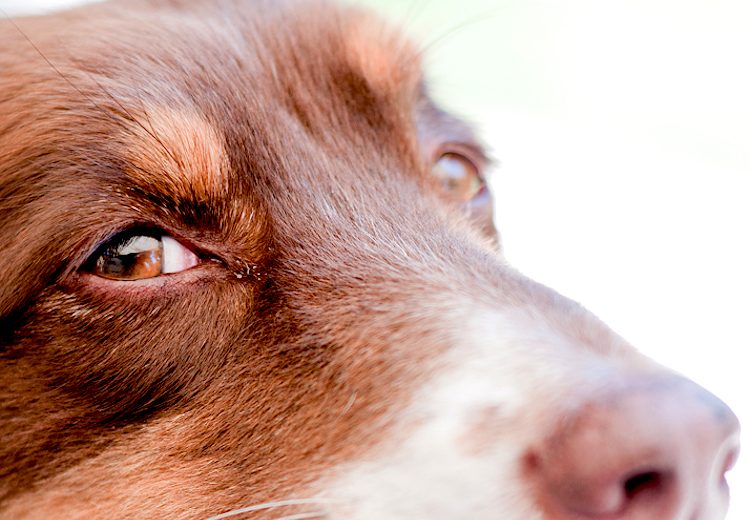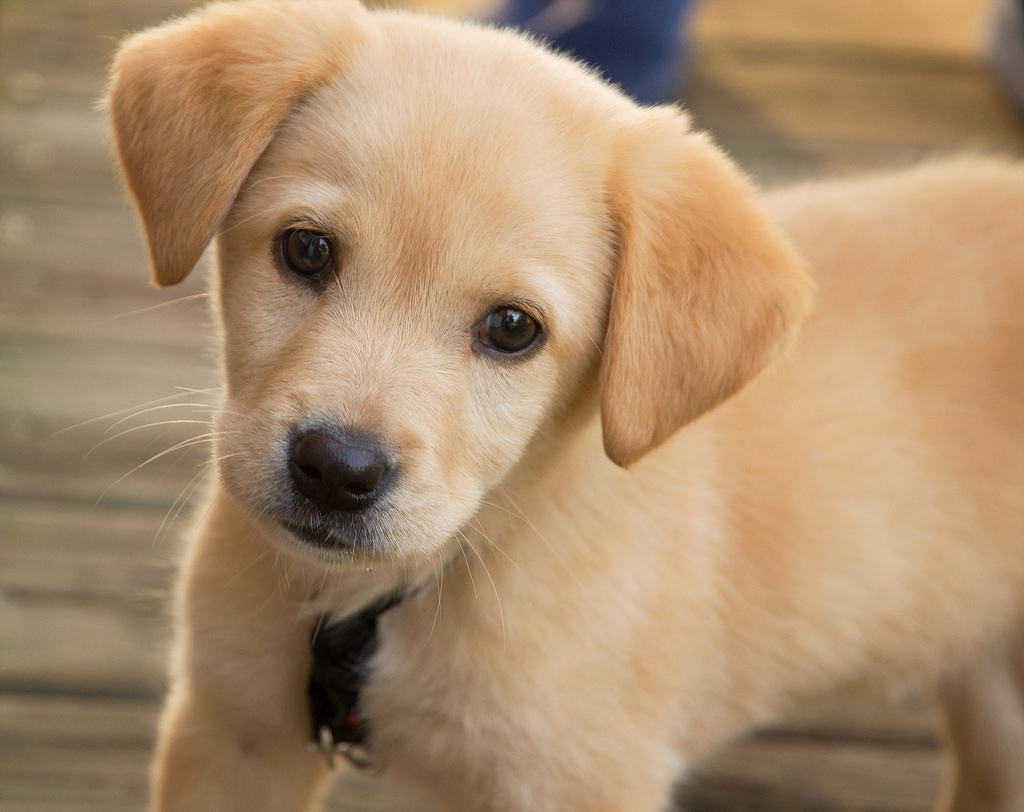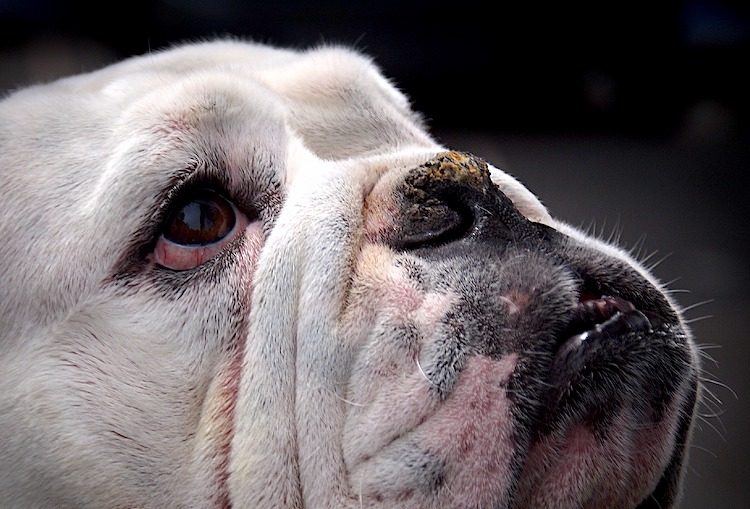
So, your dog has mucus in the eyes?
Dogs can have all kinds of discharges from their eyes, commonly called mucus. In medical terms, this is a sign of a possible problem.
But is it a true medical problem?
After the sign that there is mucus in the dog’s eyes, we need to look at the symptoms of that mucus discharge.
- Is there a change in color or consistency of the discharge?
- Are there any changes in the eye itself? (Very important.)
- Is the dog showing signs of discomfort, pain or irritation?
When a Dog Has Mucus in the Eyes
There are many dogs of different ages, breeds and conformations who develop a bit of gray discharge in the corner of the eyes.
People often call these “sleepies” or something more gross like “eye boogers” or just plain old “yuck in the eyes.”
Your veterinarian should do a complete physical exam when you come in for your regular visit and do a basic ophthalmologic exam.
This will often determine if your dog has a normal, acceptable amount of discharge in the eye or if it is abnormal.
Eye Conformation
Conformation of the eyes has a lot to do with whether or not normal ocular discharge or mucus will collect in the corners.
For example, dogs with deep-set eyes, such as Chow Chows, will naturally collect mucus and you will have to help by gently cleaning out the mucus from the inner corners.
Many dogs simply produce more mucus< than others, and the discharge may collect not in the corners of the eyes but on the skin just beneath the eyes. Gently clean this away with warm water so the skin doesn't become inflamed.
Color and Consistency of Mucus in the Dog’s Eyes
The color and consistency of the mucus is extremely important in determining whether or not the discharge is normal or abnormal. Your vet can tell a great deal simply by observing your dog’s eyes.
Normal Ocular Discharge
A gray, soft mucus discharge is usually normal.
If your vet does an eye exam and determines the eyes are completely normal with no inflammation, no conjunctivitis, etc., then the gray mucus may be normal and no treatment except gentle eye cleaning is needed.
Abnormal Ocular Discharge
- Any change in color or an acute change in the quality of the ocular discharge means there is a problem.
- Yellow or green discharge is not normal.
- A crusty consistency or an abnormal amount of discharge is not normal.
Frequently, with an abnormal discharge, there will be an obvious eye problem such as conjunctivitis.
Conjunctivitis
Inflammation of the lining of the eye, called conjunctivitis, is a common eye problem in dogs.
Symptoms of conjunctivitis are often obvious:
- Green/yellow discharge
- Red eyes
- Inflamed conjunctiva
- Pain or itchy eyes
- Squinting or keeping eyes closed
- Third eyelids prominent
Causes of Conjunctivitis in Dogs
There are many causes of conjunctivitis, and you’ll need to get a diagnosis from your vet to solve the problem. In more complicated cases, you may be referred to a veterinary ophthalmologist.
Conjunctivitis is basically inflammation, so almost anything going on in the eye can result in conjunctivitis.
Here are some of the most common causes of conjunctivitis:
- Allergies
- Infection from a virus or bacteria
- Birth defects and eyelid deformities
- Tear duct problems
- Corneal injury
- Glaucoma
- Tumors
This is not an exhaustive list. Once the cause of conjunctivitis in the dog is diagnosed, proper treatment can begin.

Epiphora: When Your Dog Keeps Tearing Up
Epiphora is an interesting word that simply means excessive tearing. There may or may not be discharge associated with the excessive tears.
Dogs with excessive tearing must go to the vet.
Why? Because there is frequently a tiny ulcer on the cornea, an eyelash abnormality or a foreign body in the eye — or the tearing is an early warning sign that the problem will only get worse.
Most of us have said, “Ouch! There’s something in my eye!” From itchy to annoying to pain, we don’t want to wait 2 minutes before we get some relief in that eye.
Was YOUR Pet Food Recalled?
Check Now: Blue Buffalo • Science Diet • Purina • Wellness • 4health • Canine Carry Outs • Friskies • Taste of the Wild • See 200+ more brands…

If your dog has excessive tearing, inflammation, abnormal discharge, keeps an eye closed or shows any evidence of discomfort like pawing at the eye, please see the vet right away.
Dry Eye in Dogs
Dry eye usually results in a sticky, thick discharge that is often hard to remove from the eye. For a variety of reasons, dry eye results because your dog is not producing enough tears.
Besides causing your dog discomfort, if dry eye is not treated, it only gets worse.
There are great medications available to treat this upsetting, chronic condition.
Many people just keep cleaning out this yucky discharge and don’t bring the dog in for a diagnosis. But early treatment saves your dog discomfort and saves you money and vet bills in the long run.
Diagnosing Eye Problems at Home
It’s a great idea to get a firm notion in your head of what your dog’s eyes look like when they are normal.
Some people don’t notice subtle to moderate changes in their dog’s eyes and can’t answer simple questions from the vet like “How long has there been mucus in your dog’s eyes?” “Or how long have the eyes been inflamed?”
- Look for perfect symmetry — both eyes should look the same.
- Eyelids should look identical.
- Pupils should be the same size.
- Eyes should be bright with no crusting or excessive discharge.
- The sclera, meaning the white around the eyeball, should be white and bright without any redness or discoloration.
- Assess the color of the conjunctiva and how much of it you can see when the eyes are normal.

All Dog Eyes Are Not the Same
There is huge variation in what is considered a normal dog eye. Much of this has to do with breed conformation.
What might be normal in a Basset Hound, for instance, with droopy eyes, would not be normal in another breed. “Buggy eyes” are normal in a Lhasa Apso but not necessarily in a Labrador Retriever.
Think about the incredible variety in our fabulous canine buddies! Here are just a few extreme examples of breeds with unique eye conformation:
Brachycephalic Breeds
These are our little pushed-in face characters like Pugs, Boston Terriers, Boxers and Shih Tzus, to name just a few.
Brachycephalic breeds and mixes are popular. These pups are prone to eye problems simply because they have the “bug eye” look and their eyes have more exposure to the environment, resulting in anything from inflammation to injury to dry eye.
Anyone with one of these adorable bundles of joy should get a good idea of what their dog’s eyes look like when they are young or first adopted. Pay special attention to any eye problems. Early intervention is the key.
For more, see our article “The Problem With Pugs: Brachycephalic Syndrome.”
Bassets, Newfies and Other Droopy-Eyed Dogs
The Basset Hound is the classic example of a breed that lives with a certain degree of eyelid deformity, meaning the eyes look a bit “droopy.”
This degree of eyelid droopiness (ectropion) can lead to conjunctivitis and other problems.
If your dog is a breed like this, be aware of the “normal” eye for your pooch and be aware of any changes. The conjunctiva is overly obvious in these dogs as well as the third eyelid or nictitating membrane.
This generally goes unnoticed at the inner corner of the eye for most breeds but is appreciated in the Basset, the Newfoundland, the Clumber Spaniel and others.
Lovers of these breeds say these dogs have “haw eyes” or appreciate the “flick of the haw.”
Dog Breeds With Deep-Set Eyes
Many breeds have deep-set eyes, and normal mucus or discharge can accumulate in the inner corners. Irish Setters come to mind, but there are many others.
This is frequently normal for these dogs. Again, pet parents must appreciate what is normal for their particular pooch.
In this video, Dr. Katy Nelson, DVM, explains more about different reasons your dog has mucus in the eyes:

Normal Pigment of the Conjunctiva
One of the most frequent things pet parents don’t appreciate when they are looking at young and healthy eyes is the color of the conjunctiva.
Labrador Retrievers come to mind as one of the most interesting cases.
Often, a dog’s conjunctiva can be quite pink. This can be normal. If, in addition, the Lab has even a tiny bit of ectropion, the conjunctiva and third eyelid can be somewhat obvious.
Many people go to the vet thinking their dog might have conjunctivitis, but it can turn out that the dog’s normal conjunctiva is fairly prominent and pink. These are always great questions to ask your vet and be aware of what is “normal” for your dog.
Get a Baseline Ophthalmology Exam
Your veterinarian should comment on any abnormalities visible in your dog’s eyes.
What if, however, there is a normal gray mucus discharge in the dog’s eyes but you cleaned the eyes that morning and your vet doesn’t see it?
Always make a list before your vet visit and remember to ask about any mucus discharge, excessive tearing, occasional redness, etc.
Most vets will recommend nothing beyond gentle cleaning at home with warm water on a tissue or cotton ball. If your dog is having any chronic eye discharge, find out what it is from your vet before trying to treat it.
References
- Gelatt, Kirk N., VMD, DACVO, et al., editors. Veterinary Ophthalmology, 5th ed. Wiley. 2013.
- Maggs, David J., BVSc (Hons), DAVCO, et al. Slatter’s Fundamentals of Veterinary Ophthalmology, 6th ed. Saunders. 2017.
- Martin, Charles L., DVM, DACVO, et al. Ophthalmic Disease in Veterinary Medicine. CRC Press. 2018.
 This pet health content was written by a veterinarian, Dr. Debora Lichtenberg, VMD. This article was originally published in 2011 and is regularly updated. It was last reviewed Aug. 20, 2019.
This pet health content was written by a veterinarian, Dr. Debora Lichtenberg, VMD. This article was originally published in 2011 and is regularly updated. It was last reviewed Aug. 20, 2019. 

